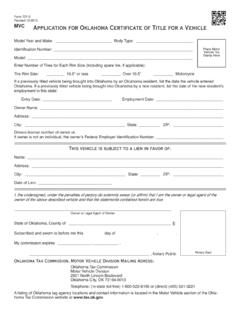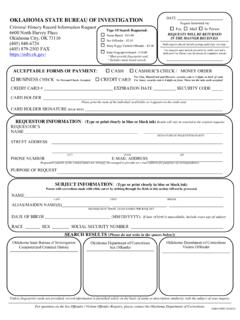Transcription of How Do Humans Affect Rivers? - University of Oklahoma
1 11 Educator s Guide to Life Along a Prairie river - A Project of the Oklahoma Biological SurveyHuman ImpactHow Do Humans Affect Rivers? Humans have a great impact on ecosystems and biodiversity. Sometimes Humans can have a positive impact on ecosystems, but often human actions can have detrimental ecological consequences. Changes in the environment that cause changes in ecosystem function can be described as is a list of some things that Humans can do that have a negative impact on river ecosystems:Damming Obstructing the flow of a river or stream for energy production, to create a lake, or to control the levels of the water.
2 Damming can be a great renewable resource for power, but it may destroy river eco-systems downstream. Damming can also be an effective flood control measure to ensure towns and neigh-borhoods are safe. Dams can obstruct the path of migratory fish and disrupt the life cycle of many different aquatic Modifying a stream or river into a pattern other than what may be its natural meandering. This can have a major effect on floodplains. Dumping Discarding materials into a river . Any chemical, such as car oil or antifreeze, poured down a storm drain will flow directly into the river . Many people don t realize this water isn t cleaned before it runs right into a natural Activities done for relaxation or enjoyment.
3 Examples of river recreation are driving ATVs, riding horses, walking a dog, fishing from a boat, or simply having a picnic. All of these activities could have a negative impact to river wildlife if not done Careless disposal of trash and waste. Domestic Animals - Waste from livestock can be washed into rivers, adding excessive nutrients and illness causing bacteria. Pet waste can also be a problem, but they are more likely to impact the wildlife of the river by chasing or hunting. Invasive species When species from far away are introduced into a new area it can have devastating ef-fects.
4 An invasive species is one that spreads into and throughout the habitat and locations of an environment, taking over other species. One alien, invasive species can totally wipe out a native species, change how the ecosystem functions, and reduce biodiversity of the area. For more information see Aliens Are Taking Over Our Rivers! section following this Deeper - Point and Nonpoint Source Pollution Point source pollution is pollution that happens at a certain location in a body of water. An example of point source pollution is when chemicals are discharged from a chemical plant into a body of water.
5 In contrast, nonpoint source pollution occurs from many scattered sources. An example of nonpoint source pollution would be storm run-off that travels through fields and picks up contaminants that eventually ends up in a river . These contaminants may be fertilizers and pesticides from agriculture or bacteria from pet waste. These pollutants can have a negative impact on water quality in our lakes and rivers. Nonpoint source pollution has been a problem in the North Canadian river in central Oklahoma . In 2007 a project was started to improve the water quality of the North Canadian river due to levels of fecal bacteria and turbidity (suspended particles in the water making it cloudy) that exceeded Oklahoma water quality levels.
6 These high levels were coming from nonpoint sources such as livestock waste, fertilizers used in agriculture, and faulty septic systems. 12 Educator s Guide to Life Along a Prairie river - A Project of the Oklahoma Biological SurveyHuman ImpactActivity - Promote Clean & Healthy RiversDesign a poster to educate your community on the importance of taking care of our rivers. Use the space below for your creative and original poster promoting clean and healthy prairie rivers. Include things you have learned from other activities found in the Prairie river Ecosystem booklet. Go the Oklahoma Biological Survey Web site ( ) to learn how to submit your poster to the Gallery of Clean and Healthy river Posters.






